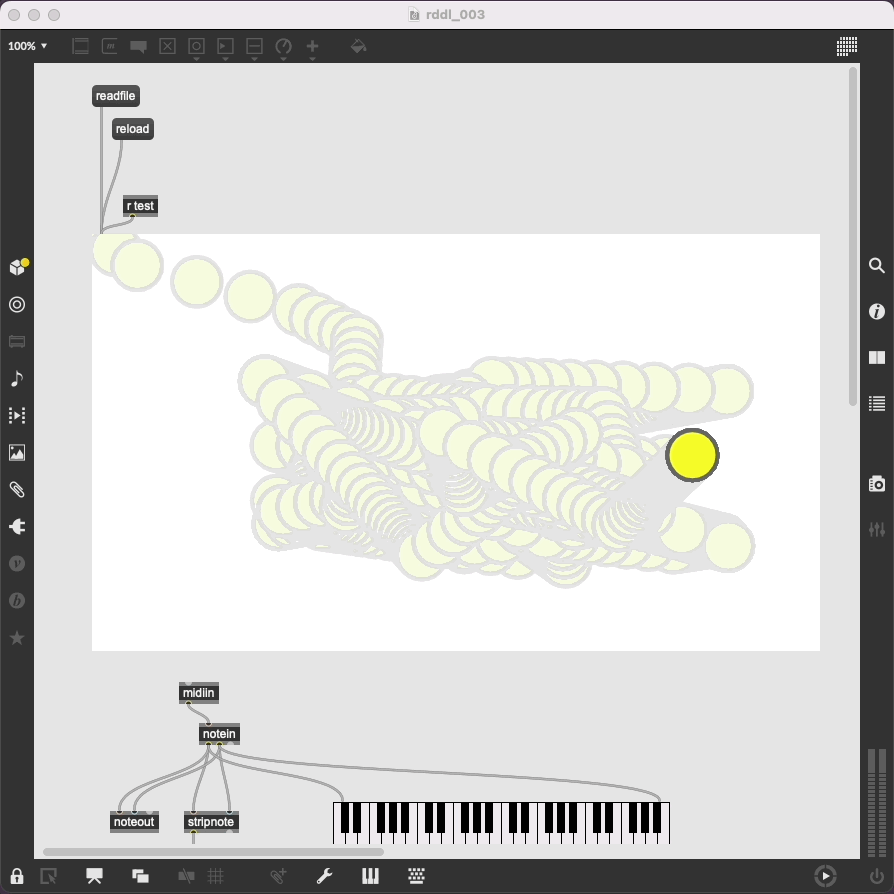
Phase 1: experimentation
Use MIDI data to manipulate the movement of a particle.
Made with Max MSP and p5.js

Made with Max MSP and p5.js
Technology and art have been related since humans discovered how to extract natural pigments in nature to use as ink, followed by the development and usage of new materials like wood, stone and metal, but have they been evolving in parallel?
While technology's main focus is to improve people's lives, art is on a mission to question society.
Both aim to interact with people and facilitate the exchange of different kinds of knowledge. Production and evolution are for technology what meaning and statement are for art. Both, however, stem from the same value: curiosity.
Curiosity drives the search for meaning; the answer to the question why. Why things work or why they work the way they do?
In this day and age, and at the time of this writing, there are over five billion searches on the Internet everyday; we are constantly looking for answers, inspiration and information.
The Internet of Things has allowed us to do just that: any-thing, and it’s just getting started.
Whether we want to learn something new, or watch videos of cats, the possibilities are endless. Unlimited information at our fingertips.
The access to information allows us to be and become at the same time. We learn, we create, we share, we consume, we produce. We are prosumers.
Art too, submerges its audience in the search for answers. It encourages participation through observing, contemplating, touching, listening and sharing. It too creates prosumers.
Through the experimentation of art and technology, design was born. It’s formed by the abstract questioning and sensitivity of art, together with the objective problem-solving and precision of technology.
If technology has given us the power to produce, share and reproduce digital content, art must propose the participation in artifact development and knowledge sharing, it could let the spectators become active in the process.
Artists could look for social interactions by producing platforms that persuade the audience's curiosity to participate and experience what happens. Guiding the audience through a surprised journey of unanswered questions that end up in more questions. Sometimes it’s not about the piece itself, but about how it came to be.
Web 2.0, gave birth to a digital overdose of online consumerism, that raises ethical questions in an unregulated platform, and promotes inequality of ownership.
It will be interesting to see what web 3.0 and the blockchain bring to the new world - both physically and digitally.
If modern art aspired to represent a vision of the world at a determined period of time, and contemporary art focuses on a perpetual existential question and analysis of the world through media experimentation. What can we expect from art in the near future?
To better explore/contemplate the future of art, we must consider the humanization of technology and the creation of virtual worlds, augmented reality and the decentralization of the web.
We are constantly creating digital platform machines that learn what we want through machine learning. Are machines really learning, or are we learning from machines?
And if new virtual worlds become our reality, what is going to be the next best representation of the world made by post-contemporary art? Would it be as virtual, as ephemeral, as public, or as viral as current products in the digital platforms?
Nowadays, there are different point of access of information depending on user roles. For example, an admin user and an end-user see different truths of the same product, after all, both users have different needs. If current technology has such disparity within a single platform, how do we ensure we all see things from the same perspective, how can we create equality in the digital world, and how can decentralization in the web bring ownership and equality?
Following our premise that art is a representation of our current world, and considering how technology continues to change the world rapidly. Perhaps art, like technology, could also have a function, rather than a contemplative approach. therefore allowing audience participation and exploration of their own creative potential in order to become prosumers. Would we all become artists, and who would be the author of authors?
The rddl project, is the exploration of what post-contemporary art could be, by merging cutting-edge technology with traditional attributes of art and design. It starts with experimentation of generative motion design, through musical harmony. the music is composed and performed by the artist, and the motion is produced/generated/manipulated by a computer program. Its purpose is to reinvent the meaning of an art piece in today’s environment. Using the blockchain technology to host the outcome of the piece and to reach its audience.
In short, rddl is a generative art project, some might get it, some might not. After all, art can be anything and technology can become anything.